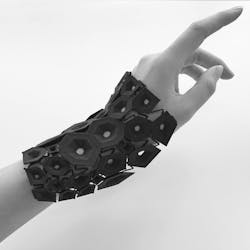3D-Printed Costumery Creates Juxtaposition between Culture, Theater, and Tech
The production of “Farewell My Concubine” at the Royal College of Art (RCA), London has a unique twist that is sure to attract a diverse audience on its opening night, December 1. Audience members with interests in fashion, technology, Eastern culture, and theater alike will be entertained by actors wearing unique pleated costumes created with the selective laser sintering (SLS) 3D printer, Sinterit Lisa. To see an example of the costumes, watch a video below!
The work is part of RCA’s Fold the Inter-Fashionality project, which calls on the use of contemporary technologies to create fashion items commonly achieved through traditional craftsmanship. The PhD candidates used 3D printing to achieve their costume designs, creating a new textile called Flexa Black that imitates the traditional Eastern art of pleating.
Students, MingJing Lin and Tsai-Chun Huang created algorithms that could be read by the printer software to generate pleated fabric that contours actors' bodies. SLS 3D printing uses these algorithms to selectively harden parts of a mass powder in a vat. After curing by a laser, the pleated design remains intact and excess powder is removed, as shown below.
“It was important for us to create a new, groundbreaking costume, which shape and form will refer to the traditional Beijing Opera,” says Lin. “In accordance with the previous aesthetics the project has assumed a simplification of the form – more subtleness thanks to using monochromatic colours and less decorations – says the designer, Mingijing Lin – The costumes have been printed with SLS technology offered by Sinterit 3D printers. Over-designed and complex projects could not be executed with the use of classic techniques of constructing and sewing fabrics. The properties of the Flexa Black fabric allowed us to maintain the geometrical structure of the costume and a softness resembling that which characterizes traditional fabrics.”
To see an example of the costumes, watch the video below.
About the Author
Leah Scully
Associate Content Producer
Leah Scully is a graduate of The College of New Jersey. She has a BS degree in Biomedical Engineering with a mechanical specialization. Leah is responsible for Machine Design’s news items that cover industry trends, research, and applied science and engineering, along with product galleries. Visit her on Facebook, or view her profile on LinkedIn.


